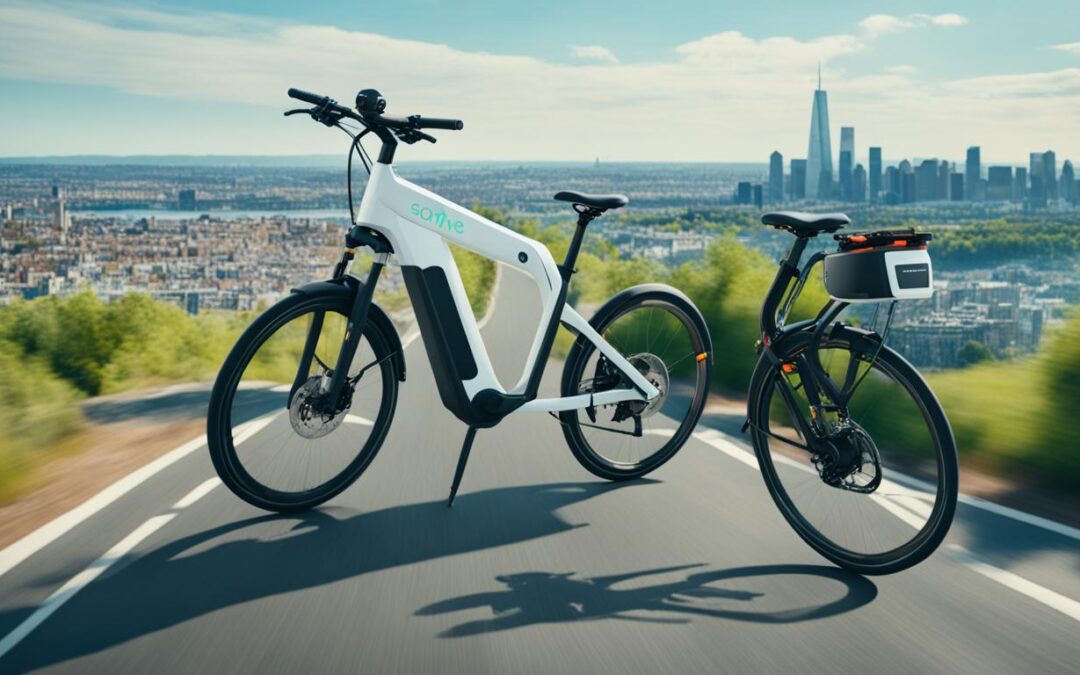Electric bikes, often referred to as e-bikes, have gained popularity as a convenient and eco-friendly mode of transportation. The terms “e-bike” and “electric bike” are used interchangeably, but there is no technical or legal distinction between them. However, there are different types of electric bikes, each with its own unique features.
E-bikes are bicycles powered by an electric motor, offering benefits such as easier commuting, reduced carbon emissions, and a more affordable alternative to driving a car. Whether you’re considering an e-bike or an electric bike, it’s important to understand the distinctions and similarities to make an informed decision.
Key Takeaways:
- E-bikes and electric bikes are terms used interchangeably with no technical or legal distinction between them.
- There are different types of electric bikes, such as pedal-assist bikes and throttle bikes, each offering unique features.
- E-bikes provide easier commuting, reduced carbon emissions, and an affordable alternative to driving a car.
- Consider factors such as cost, weight, maintenance, speed, exercise benefits, and legal regulations when choosing between e-bikes and electric bikes.
- Choose the bike that best suits your riding style and needs.
Types of Electric Bikes
When it comes to electric bikes, there are various types available, each offering a unique riding experience. Understanding the different categories can help you choose the right e-bike for your needs. Let’s explore the most popular types:
Pedal-Assist E-Bikes
A pedal-assist e-bike, also known as a pedelec, provides power assistance only when the rider is pedaling. The electric motor seamlessly kicks in to amplify your pedaling effort, making cycling easier and more efficient. This type of e-bike encourages an active, healthy lifestyle while providing an extra boost when needed.
Throttle E-Bikes
Throttle e-bikes, on the other hand, allow the rider to control the power output without any pedaling. These bikes are equipped with a throttle located on the handlebars, enabling you to effortlessly accelerate and maintain a constant speed. Throttle e-bikes are particularly convenient for riders seeking a more relaxed or leisurely experience.
Speed Pedelecs
Speed pedelecs, also known as high-speed electric bikes, offer exhilarating rides with their ability to reach higher speeds of up to 28 mph. These e-bikes are designed for those who prefer a faster commute or exhilarating rides. It’s important to note that speed pedelecs are classified as mopeds in some countries, which may require a license to operate.
The legal classification of e-bikes may vary depending on the country or region you reside in. It’s crucial to familiarize yourself with the local regulations regarding electric bikes to ensure compliance and a safe riding experience.
Now that you’re aware of the different types of electric bikes, you can choose the one that aligns with your preferences and goals. Whether you opt for a pedal-assist e-bike, a throttle e-bike, or a high-speed pedelec, the world of electric bikes offers a range of options to suit every rider.
Stay tuned for the next section, where we’ll delve into how electric bikes work and explore their essential components.
How Electric Bikes Work
Electric bikes, also known as e-bikes, are designed to provide an enhanced cycling experience through the integration of electrical components. While they resemble regular bicycles, their key components differentiate them and offer unique functionalities to riders. Understanding how electric bikes work involves exploring the various components that make up these innovative modes of transportation.
Electric Bike Components
An electric bike consists of several essential components that work together to deliver an efficient and enjoyable riding experience. These components include:
- Motor: The motor is the heart of an electric bike and plays a crucial role in providing assistance to the rider. It converts electrical energy from the battery into mechanical energy, which assists in pedaling and propels the bike forward. The motor can be located in different positions, such as the hub of the front or rear wheel or the bottom bracket.
- Battery: The battery serves as the power source for the electric motor. It stores and supplies the electrical energy needed to assist the rider’s pedaling. The battery’s capacity determines the range and duration of an electric bike’s assistance. Lithium-ion batteries are commonly used due to their high energy density and lightweight nature.
- Display: The display is an LCD screen or LED panel mounted on the handlebars, allowing riders to access important information about their electric bikes. It typically provides details such as speed, battery level, distance traveled, and power mode settings.
- Controls: Controls are the interface through which riders manage the power output and various settings of their electric bikes. These controls typically include buttons or switches located on the handlebars, allowing riders to adjust the level of assistance provided by the motor.
- Sensor: The sensor detects the rider’s pedaling motion and signals the motor to provide assistance accordingly. It ensures that motor assistance is synchronized with the rider’s effort, creating a seamless and intuitive riding experience.
To better visualize the components of an electric bike, refer to the diagram below:
Maintenance and Repairs
Proper maintenance is key to keeping your electric bike running smoothly and extending its lifespan. While some aspects of maintaining an electric bike are similar to those of a regular bike, there are specific considerations for the electrical components.
Regular bike maintenance
A good starting point for maintaining your electric bike is to follow regular bike maintenance practices. This includes checking and adjusting brakes, lubricating the chain, and inflating tires to the recommended pressure.
Listed below are some common regular bike maintenance tasks:
- Brake adjustment and pad replacement
- Gear alignment and adjustment
- Tire inspection and inflation
- Chain lubrication and cleaning
You can perform these tasks yourself if you have the necessary knowledge and tools. Alternatively, you can visit a local bike repair shop for professional assistance. Many bike shops offer maintenance packages that include services like tune-ups and tire replacement.
Electrical component maintenance
Electric bikes have additional electrical components that require specialized maintenance. While the motor and controller typically do not require regular servicing, the battery is a crucial component that may need special attention.
Below are some tips for maintaining the electrical components of your electric bike:
- Protect the battery: Keep your battery protected from extreme temperatures, as both high heat and freezing temperatures can negatively impact its performance and overall lifespan.
- Charge the battery correctly: Follow the manufacturer’s instructions for charging the battery, as overcharging or not charging it fully can affect its capacity and longevity.
- Clean electrical connections: Periodically check and clean the electrical connections between the battery, motor, and display to ensure a solid connection and prevent any issues caused by dirt or corrosion.
- Check electrical cables: Inspect the electrical cables for any signs of damage or wear. If you notice any frayed or damaged cables, have them repaired or replaced by a professional.
If you experience any issues with the electrical components of your electric bike, it’s best to consult a bike repair shop with experience in electric bikes. They will have the expertise and tools to diagnose and repair electrical problems effectively.
| Maintenance Task | When to Perform |
|---|---|
| Brake adjustment and pad replacement | Regularly, depending on brake wear |
| Gear alignment and adjustment | Regularly, especially after gear shifting issues |
| Tire inspection and inflation | Regularly, before each ride |
| Chain lubrication and cleaning | Every few rides or when the chain appears dry or dirty |
Riding Experience and Speed
Riding an electric bike provides a unique and exhilarating experience that combines the joy of cycling with the added benefit of pedal assist. With electric bikes, you can effortlessly cruise through various terrains and explore new destinations with ease.
The pedal assist feature is a game-changer, making pedaling much easier by providing additional power from the motor. This means you can tackle hills, headwinds, and longer distances without feeling exhausted. It’s like having a personal cheerleader boosting your pedaling efforts.
The transition between pedaling and motor assistance is seamless, creating a smooth and satisfying riding experience. The pedal assist engages as soon as you start pedaling, offering an immediate boost and allowing you to maintain a consistent speed.
One of the key advantages of electric bikes is their speed capabilities. The speed varies depending on the specific model and class of the e-bike. With pedal assistance, some electric bikes can reach speeds of up to 20 or 28 mph, enhancing your riding experience and expanding your range.
It’s worth noting that speed can also be controlled with throttle e-bikes. These bikes allow you to achieve higher speeds without the need for pedaling, making them great for quick bursts of acceleration.
E-bike speed, however, is not solely dependent on the electric motor. It also depends on how much effort you put into pedaling. The more you pedal, the more power the motor delivers, enabling you to cruise at faster speeds.
To better understand the speed capabilities of electric bikes, here’s a brief breakdown:
| E-Bike Class | Maximum Speed with Pedal Assist |
|---|---|
| Class 1 | Up to 20 mph |
| Class 2 | Up to 20 mph |
| Class 3 | Up to 28 mph |
Remember, always ride responsibly and be mindful of local speed limits and regulations.
So, whether you’re looking for a thrilling ride or a more leisurely cruise, electric bikes provide a versatile and dynamic riding experience. With their pedal assist and varying speed capabilities, you can tailor your e-bike adventure to match your preferences and desired level of exertion.
Conclusion
When it comes to choosing between an e-bike and an electric bike, the decision ultimately rests on your personal preferences and the specific purpose you have in mind. E-bikes are an excellent choice for commuters and those looking to cover long distances, thanks to the pedal-assist feature that makes cycling easier, even for individuals who may not be as young or fit. Electric bikes, on the other hand, are ideal for leisurely rides or riders seeking assistance on hilly terrain.
In contrast, traditional bikes may be better suited for shorter rides or individuals who prefer a more conventional cycling experience. The key factors to consider when making your decision include cost, weight, maintenance requirements, speed capabilities, exercise benefits, and legal regulations. Each of these factors plays a crucial role in determining which type of bike will best suit your riding style and individual needs.
Ultimately, the choice between an e-bike and an electric bike boils down to what aligns with your preferences and intended usage. Whether you opt for an e-bike to make your daily commute a breeze or an electric bike for leisurely rides, choosing the right bike will enhance your cycling experience and help you enjoy the benefits of this eco-friendly mode of transportation.
FAQ
What is the difference between an e-bike and an electric bike?
There is no technical or legal distinction between the terms “e-bike” and “electric bike.”
What are the types of electric bikes?
There are pedal-assist e-bikes, throttle e-bikes, and speed pedelecs.
How do electric bikes work?
Electric bikes have components such as a motor, battery, display, controls, and sensor that work together to provide pedal assist and power.
How do I maintain and repair an electric bike?
Regular bike maintenance can be done at any bike repair shop, but electrical components may require specialized maintenance.
What is the riding experience like on an electric bike?
Electric bikes provide pedal assist to make pedaling easier, and the speed capabilities vary depending on the model and class of the e-bike.
How do I choose between an e-bike and an electric bike?
It depends on personal preference and the intended use of the bike. Factors to consider include cost, weight, maintenance, speed, exercise benefits, and legal regulations.

